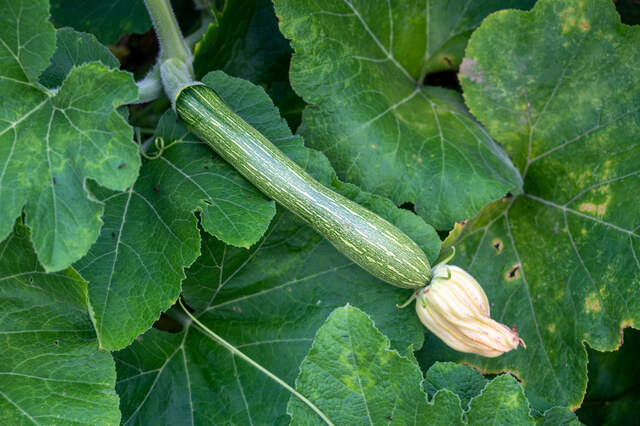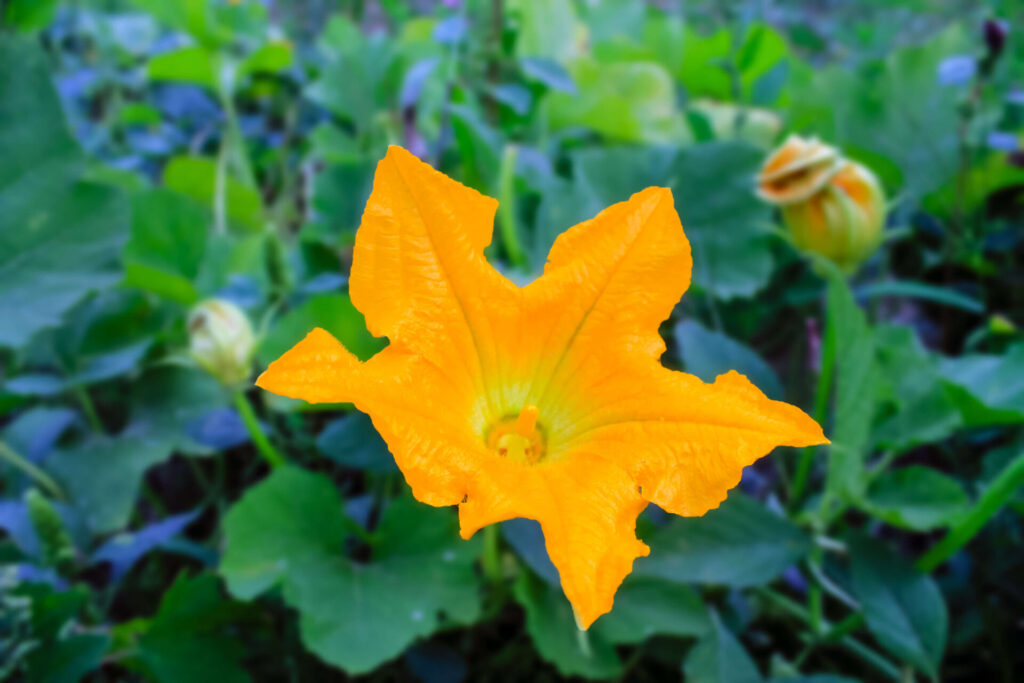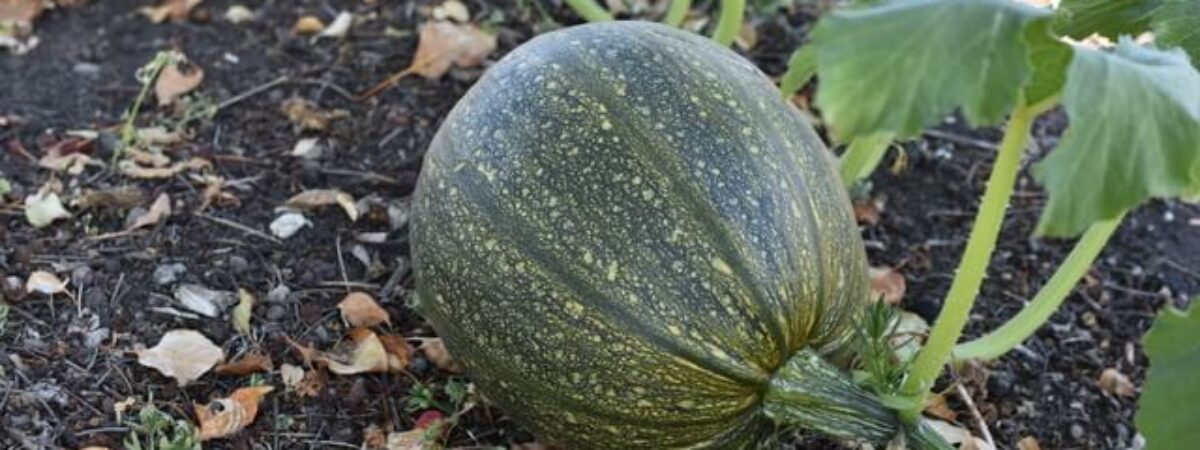Plant species in the genus Cucurbita that are known as pumpkins include Cucurbita pepo, Cucurbita mixta, Cucurbita maxima, and Cucurbita moschata.
Pumpkin belongs to the Cucurbitaceae family and is commonly grown as a vegetable or ornamental plant. Pumpkin vines are short-lived annual or perennial vines that include branching tendrils and big lobed leaves.
Huge yellow or orange blossoms, as well as a pumpkin-like pepo fruit, are produced by this plant. The plant’s skin is normally ribbed and orange in color, while some variations are green, gray, yellow, or red in hue.
Green pumpkins have evolved naturally as well as through manual intervention. Green pumpkins can be produced with the use of genetic alterations and a variety of harvesting methods.
Green pumpkins are also edible and can be transformed into orange pumpkins if desired.
They come in a variety of forms and sizes. Many of them are spherical, with deep ridges and a hard exterior, while others have a smooth exterior.
Green pumpkins can also have an oblate form, speckled stripes, or be covered in bumpy warts. Click To TweetGreen pumpkins can also have an oblate form, speckled stripes, or be covered in bumpy warts.
The insides of the green pumpkins are identical to those of an orange or yellow pumpkin, with huge, flat white seeds.

Furthermore, the inside flesh is starchy and has a texture similar to the insides of a potato.
Green pumpkins can be purchased in a grocery shop, farmer’s market, pumpkin patch, or even at a pumpkin festival.
You might want to do some study before picking a green pumpkin because some of them aren’t as popular commercially.
Green pumpkin seeds can be purchased from specialized seed dealers or any garden and home improvement store if you want to grow them yourself. Because there is less demand for the seeds, they may be less expensive than ordinary pumpkin seeds.
Varieties of Green Pumpkins
Marina Di Chioggia
Chioggia, a fishing village on Italy’s south coast, is where this pumpkin was born. It is without a doubt one of the most stunning and distinctive green pumpkin varieties available. They have a vivid orange-yellow flesh that is delicious and rich. The extremely warted rinds that encircle the surface of these pumpkins are easily distinguishable.
Kabocha
Kabocha is a Japanese Asian pumpkin type with a typical sweet flavor. The inside of this pumpkin has a fluffy texture, comparable to that of a chestnut.
The pumpkin is identified by its hard, speckled or thin rinds on the outside, which may also have bright green stripes.
Lakota Squash
The Lakota squash has a nutty, fine-grained flesh that makes it a wonderful winter squash. Their pear-like form and stunning orange rinds with green streaks make them readily recognisable.
Green Hubbard
Green Hubbard is another winter squash variety with an oblate or tear-like form. This type has a rough and thick surface. Additionally, the inside flesh is bright yellow in color and has a sweet flavor, making it ideal for baking or steaming.

Bonbon Pumpkin
Bonbons have a homogeneous appearance, with slight flattening around the poles and a spherical shape with square shoulders. They have a semi-bumpy and rough rind that is dark green-gray with thin silver-green lines. The smooth, thick, and bright orange meat lies beneath the rind. When sliced, this type has a cucumber-like scent, and when cooked, the flesh has a sweet, honey-like flavor.
Growing Guide
The best way to grow pumpkins is to plant the seeds directly in the ground. Before putting seeds outside, wait until the plant-soil temperature reaches 70°F or above.
The ideal soil temperature is 95 degrees Fahrenheit. Pumpkins are delicate plants that are easily damaged by the cold. Choose a location where direct Sunlight falls.
Pumpkins usually require a bigger room for their expanding vines. Per hill, vine varieties require 50 to 100 square feet. Click To TweetPumpkins usually require a bigger room for their expanding vines. Per hill, vine varieties require 50 to 100 square feet.
Grow pumpkin vines over the lawn or sidewalks so they grow along the garden’s edge. Pumpkins can also be grown in large 5 to 10-gallon buckets.
Pumpkin seeds must be sown in mounds approximately one to two inches apart, with even rows nearly six feet apart. Plant approximately four to six seeds per hill.
Keep in mind that spacing the mounds by 1.5 to 2 feet will allow the plants to get enough sunshine while preventing overpopulation.
In terms of climate, pumpkins thrive in tropical settings where the temperature is consistently warm. In temperate climes, on the other hand, the best time to plant pumpkins is right after the cold season, in late May or June, because frosting can kill the plant.
For planting indoors, you can follow the following steps of growing.
Pumpkins can also be grown indoors if you live in a chilly climate. In that instance, three or four seeds should be sown in small pots and placed near a sunny windowsill for four to six weeks.
If you can’t find a natural light source, use a heating pad with a fluorescent lamp to help the plant grow.The soil should be moist but not overly so. Germination will take roughly two weeks to appear after that.
Lower watering frequency before taking the plants outside to the garden and then plant the pumpkins similarly as mentioned above for planting outside.
Caring Guide
Soil
Green pumpkin prefers moist, rich soil that has well drained capacity. It is best to add compost to the soil before planting the pumpkin seeds.
Light
Green Pumpkin requires full bright Sunlight for the production of flowers and fruits as well.
Watering
Dry circumstances are not a problem for pumpkins. Extended dry periods, on the other hand, might have a negative impact on the size and growth of the fruits.
Overwatering pumpkin plants, on the other hand, can cause infections and the fruit to spoil. Deep watering per week is recommended for best results.
Mulch can help gardeners suffering with soil upkeep keep a healthy level of moisture in the area where pumpkins are growing. Finally, gradually lower the amount of water as the fruits ripen.
Temperature and Humidity
Pumpkin as a member of the eggplant family, prefers warm summer temperatures of 75 degrees Fahrenheit or higher. Humidity is not a crucial growth element; in fact, fungus can spread under high humidity.
Fertilizer
Pumpkins will grow more evenly and healthily if they are fertilized with all-purpose and nitrogen fertilizers. You just need to fertilize it twice before planting and once when they show signs of producing vines.
Pruning
Because pumpkin plants grow quickly and demand a lot of area, there’s a good chance the field will be overcrowded. Overcrowding can cause small, underdeveloped fruits to remain that way, as well as other types of plant trauma, which can force the plant to self-destruct.
You can thin out the plants by pruning the vines and leaves to control overpopulation. Once the freshly produced plants have matured, reduce the mounds to one or two plants a piece.
Harvesting
Pumpkins are annual plants that can bloom at any time of year, depending on the location and temperature. Pumpkins can be grown from April to fall in temperate areas.
However, while pie pumpkins and small pumpkins may be ready to harvest as early as August, most medium-sized pumpkins will take around four months to mature.
The harvesting process begins once the pumpkins have developed a bright, even green color and a hard exterior.
It’s critical to make a clean cut from the vine and avoid bruising the fruit or damaging the stem, as pumpkins without stems begin to deteriorate just a few days after harvesting.
Problems
There are not many major pests or diseases that can harm green pumpkins, it’s still important to keep them safe from the elements.
Squash bugs and cucumber insects wreak havoc on vines, causing holes, droopy leaves, and severe discoloration.
Squash bugs are easy to catch and kill, but cucumber beetles require more than pyrethrin-based insecticides. To drown the beatles, use a solution of ammonia and soapy water. Creating mounds around the plants can also help keep insects from depositing eggs.
The presence of sunflowers is another way to divert these pests. To keep your green pumpkins secure from infestation, grow sunflowers in each row of your pumpkin patch.
Powdery mildew is the most dangerous type of pumpkin disease because of its rapid growth and disorganized spread. When leaves and other above-ground plant parts are exposed to water for an extended period of time, this mold-like fungus can form.
Powdery mildew can be controlled by avoiding soaking the foliage and overloading the plants. Furthermore, watering plants first thing in the morning allows them to dry as rapidly as possible during the day. Furthermore, fungicides should be used to permanently eliminate the threat.
Conclusion
Green pumpkins are undeniably distinct from their yellow counterparts, and they are also more delectable. However, green pumpkins should not be confused with immature yellow or orange pumpkins, as the latter have a different flavor than green pumpkins.
Hence you should definitely try your gardening hands to grow these green Pumpkins in your garden and enjoy the fresh fruits.
If you have any queries regarding planting of Pumpkins then feel free to ask in the comments section below and share your experience too.






